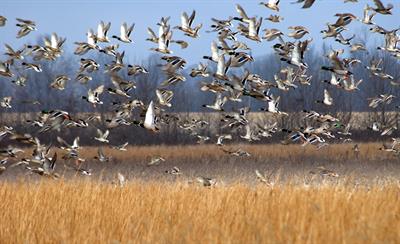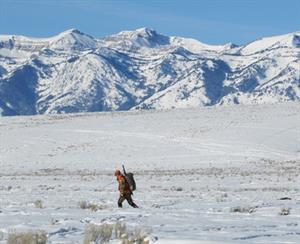Like many hunters, your case of buck fever began to develop weeks before the season as you pored over copies of
Field and Stream, reading up on the latest strategies and pondering the newest high-tech gear. A couple of days before big-game season opened, you dutifully washed your camouflage jacket in fragrance-free detergent and stopped by your favorite outdoor equipment store to grab some Scent-A-Way long johns.
On the day of your first hunt, you parked your truck along a road where you always see deer crossing, gathered the gear as quietly as you could, and crept into the timber at first light, your nose into the wind.
Perhaps a short while later, you stopped to marvel at the glorious silence of the forest, broken only by a distant bird chirping, “ts-ts-ts.” You stood stock-still, confident of your invisibility as you waited for a deer to emerge into view.
But guess what? Chances are good that every deer, elk, bird, and squirrel within the farthest range of your high-powered rifle was fully aware of your presence.
And there’s nothing your clothes, your soap, or your stealthy movement could have done about it.
In fact, those very elements might have been part of what signaled to the animals that danger was nigh, says Erick Greene, a professor of biology at the University of Montana.
“By the time you’ve snuck into an area, the deer and elk and turkeys have known for quite a while that you’re coming,” says Greene. “They know that somewhere in your vicinity, there’s a sneaky bugger moving slowly and stealthily on the ground. They’ve got a fix on you.”
Those are just some of the implications of Greene’s latest research, which is shedding surprising light on how animals communicate — often with remarkable detail and even across taxonomical classes — about the presence and nature of danger.
Surprise Discovery
The project had its beginnings several years ago, while Greene was working on a project that catalogued and analyzed the song-learning techniques of lazuli buntings — small, blue-headed songbirds that congregate on the flanks of Montana’s Mount Jumbo and Mount Sentinel in the summertime.
As part of that research, Greene spent time testing the territorial behavior of male buntings by playing recordings of other males’ songs on loudspeakers hidden in the brush.
Most of the time, the male bird that had staked out that particular plot of land as his own would come flying in quickly and proceed to make a raucous display of himself, flying around the hidden speaker and singing aggressively.
But then, sometimes, something unusual would happen.
“All of a sudden, the bird would stop responding and go on super-high alert,” recalls Greene. “He would get quiet, look around, and then just dive down deep into the nearest bush.”
After experiencing this phenomenon a few times, Greene began to notice a broader context to the behavior.
“I noticed that not only did this particular male stop singing, but all the birds had gone silent, like you’d muted the volume on the radio,” he says. “Then, a few minutes later, I would hear this ripple of ‘seet’ calls.”
 Greene already knew the meaning of so-called “seet” calls, which birds of various species employ — with remarkable consistency of sound, even on different sides of the world — to warn of flying raptors. Sure enough, whenever Greene heard that wave of calls, he would soon observe a hawk flying through the area.
Greene already knew the meaning of so-called “seet” calls, which birds of various species employ — with remarkable consistency of sound, even on different sides of the world — to warn of flying raptors. Sure enough, whenever Greene heard that wave of calls, he would soon observe a hawk flying through the area.
That much made sense. But something about the experience didn’t quite jibe with the prevailing theories among biologists about the nature of such communication.
“The dogma in the literature has been that these specific alarm calls for flying birds of prey are meant for local consumption, in the sense that they don’t travel far,” he says. “The idea is that, if you’re a bird giving a ‘seet’ call, you’re warning your mate or your chicks.”
“But the observations that I’ve made over the years started convincing me that that’s complete hooey. All those buntings in the area knew there was an inbound hawk, three to five minutes before the hawk got there. They were all hiding down in the bushes by the time it flew through. That’s when the light bulb went on.”
Working with researchers at Cornell University’s Lab of Ornithology, Greene began collecting data on what he terms “distant early warning systems” employed by prey animals to protect each other from impending danger.
One of his first experiments involved situating an array of microphones along the Kim Williams Trail in Missoula, each connected to a recorder. Greene would play a recording of seet calls made by robins in response to an overhead falcon and record the response of birds in the area.
“With these arrays of microphones, you can see the rapid spread of this band of silence, where the first thing all the birds do is shut up and listen,” he says. “Then you see almost immediately you hear a wave of seet alarm calls.”
Greene found that the alarm calls were passed from bird to bird across the landscape at speeds of up to 120 miles per hour. What’s more, the warnings often traveled a half-mile or more from their source.
“In essence, there’s this wave of information, like the bow wave of a ship, that precedes the predator — and it is moving way faster than the predator,” he said.
Greene has also found that birds have different types of alarm calls for different types of danger: a call for ground-based predators that are creeping slowly along, a call for raptors perched in treetops, and so-on.
If any of this comes as a surprise to you, it is probably even more unexpected from the hawk’s perspective.
“We know that these little birds hear those sounds much better than we (humans) do because their ears are tuned to them,” said Greene. “We also know that hawks and owls are virtually deaf in that frequency range. So the songbirds are broadcasting on a channel that their predators basically don’t even know about.”
Treetop Tattletales
For hunters, the problem is that songbirds are not the only ones listening to and sharing this information.
“Any hunter is familiar with those pine squirrels that start yakking at you and won’t shut up,” says Greene. “Those are alarm calls. Squirrels do give ‘seet’ alarm calls for flying raptors, but they give these other, acoustically different alarm calls for terrestrial predators. If there’s a squirrel that gets particularly irate at you, you’ll hear another one start up and pretty soon, half a mile away there are squirrels talking. Everything in that area knows that there’s something over here and there’s some positional information that they can basically triangulate.”
“That signal is containing quite specific information, telling all the other squirrels and birds in the area that there’s something on the ground disturbing the squirrel,” Greene continues. “If there’s a bunch of birds foraging on the ground and they hear that call, you’ll see them immediately fly up into the trees, and they will also communicate the information on down the line.”
Greene says that game animals are tuned into these alarm calls as well. While little specific research exists on big-game animals’ engagement in the alarm communication network, some fascinating research has been done with prairie dogs by a researcher at Northern Arizona University.
There, professor Con Slobodchikoff has shown that prairie dogs give one type of alarm call when a person walks through an area with a gun over his shoulder and a different alarm call when a person appears with a telescope and tripod over his shoulder.
“They know that one is a nerdy biologist watching them and the other is somebody trying to take them out,” says Greene, noting that the animals have also been shown to employ different alarm calls in response to people wearing different-colored clothing. “Prairie dogs have learned that there’s an important distinction, and they are fast to communicate that to one another.”
Missing Pages?
 Of course, as any hunter with a freezer full of meat knows, the system doesn’t always work in the animals’ favor. “It’s not a fail-safe system, obviously,” says Greene.
Of course, as any hunter with a freezer full of meat knows, the system doesn’t always work in the animals’ favor. “It’s not a fail-safe system, obviously,” says Greene.
Wind, snow, and other environmental elements can serve to muffle alarm calls. During the elk rut, squirrels sometimes give alarm calls in response to a creeping bull that is trying to sneak in on another male’s harem — a fact that might actually draw the herd bull toward the perceived danger.
And sometimes, as hunters are well aware, those typically talkative squirrels simply go about their business, making nary a sound.
But Greene’s research points to some intriguing questions that could challenge the prevailing wisdom about slow-stalk hunting.
Might hunters be perceived as less of a threat if they move casually and quickly along through the woods? Is camouflage clothing really a help, or might it be perceived as a signal of predatory intent? Do squirrels and birds key into that gun slung over your shoulder?
“I don’t think we know the answers to those questions,” says Greene. “What I would say is that in the hunting world, people pay a lot of attention to smell. But possibly as important — and in some cases, probably more important — is this information landscape that the animals are plugged into that people don’t pay much attention to.”
“You might be doing everything by the book, but the book appears to be missing some pages.”